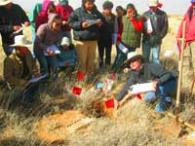Pedoderm and Pattern Classes (PPCs) comprise three simple indicators of soil surface processes affecting plant growth and ecosystem function. The pedoderm class (PC) describes the type of material that occurs at the air-soil interface--the 'pedoderm' or upper 3 cm of the soil surface. The resource retention class (RRC) classifies the spatial pattern of persistent vascular plants and interpatches that govern resource movement and erosion rates. The soil redistribution class (SRC) uses several surface features, such as pedestals and depositional mounds, to classify the spatial extent and severity of erosion and deposition. These indicators can link surface soil processes to explanations of ecosystem change in state-and-transition models.
Staff at the Jornada and NRCS developed these new indicators to enable rapid inventory of soil surface attributes that are otherwise difficult to record and, therefore, typically not represented in inventory datasets. PPCs complement observations of plant community attributes and soil profiles or ecological sites to provide a more complete representation of ecosystem characteristics. In doing so, PPCs provide a readily-accessible language for discussing the role of soil surface processes in ecosystems that can be applied by soil scientists and other natural resource professionals conducting extensive field surveys.
To serve the needs of those making large numbers of observations across a landscape, the PPCs were designed to be recorded quickly (5 minutes once proficient with the classes). The individual PPCs integrate observations of several attributes that are treated separately in other indicator systems, such as Interpreting Indicators of Rangeland Health and Landscape Function Analysis. Thus, PPCs build on existing knowledge used by natural resource professionals. PPCs do not rely upon qualitative modifiers or knowledge of reference conditions. Iterative consistency trials have been conducted resulting in the current PPC dataform and field book. PPCs have been applied in desert, grassland, shrubland and woodland systems in several countries and materials have been translated into Mongolian and Chinese.
PPCs are now included in the recent NASIS update, with modifications to the pedoderm class table to facilitate compatibility with prior fields.
Pedoderm and Pattern Class dataform (Excel) (v. 3.0) Indicators of Soil Surface Processes for Inventory: NEW → A Field Guide to Pedoderm and Pattern Classes - Chinese version Pedoderm and Pattern Class Workshop presentation - slides in pdf |
 Brandon Bestelmeyer (kneeling in the center) demonstrates soil data collection. Useful site interpretations can be developed from the combination of soil profile, vegetation, and PPC data. Brandon Bestelmeyer (kneeling in the center) demonstrates soil data collection. Useful site interpretations can be developed from the combination of soil profile, vegetation, and PPC data. | |
| |



